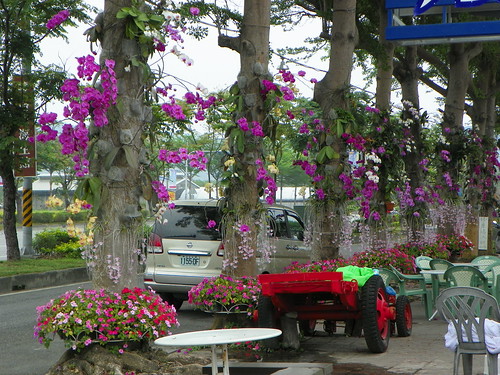reply to my thread about florida natural farming (fnf)...
****************************
fnf has several large inga trees and each time he says that they are going to finally fruit, but every time, at the very last minute, they trick him. it’s a bit entertaining and endearing.
i don’t think that i’ve ever heard fnf mention that fruit trees near the ingas grow extra fast, which is interesting because check this out…
the cacao on the left isn’t growing anywhere near any ingas, while the cacao on the right is growing in an inga alley. fake news? the slide is from this video on inga alley cropping, which i only recently learned about thanks to the wikipedia article on mycorrhiza. here’s the wikipedia article on inga alley cropping.
naturally i was quite curious if it has ever been discussed here on tff, and it has been, albeit briefly…about the inga genus. in that 2017 thread there were only 4 participants, one of which was pineislander. he was there. where were we? not there.
one time, nearly a decade ago, at an orchid show i started talking with a random guy. he mentioned something about the orchidboard, and i told him that i was on there as well. i asked him what his username was. when he said what it was, i realized that he was the guy on there who told me to go f myself because he thought my views on orchid conservation were heretical.
flauro01, hint matthew 5:38? nope, i didn't turn my other cheek, i quickly lost all interest in talking with the guy and exited stage left. if i had been a little forgiving then i'm sure that i would have learned some useful stuff from him.
i only made 1 comment on fnf's videos, and he deleted it. in his video he said something about being overwhelmed trying to do everything on his own, so i commented that i’ve met a lot of young and enthusiastic plant people via my local facebook plant group who have been more than willing to lend a hand in my garden. my comment wasn't even vaguely negative or critical, so the fact he deleted it was very off-putting. fortunately, in this case, being so much older and wiser (hah) i just barely managed to turn the cheek and i continued to watch his videos, and i’ve learned useful stuff from them.
sure, it would greatly help fnf's cause if he was more like fff planting garcinias together with an enthusiastic young person, but that's just not who he is. just like most of us don't regularly video document our garden efforts, endeavors and experiments. we all have room for improvement.
in my book, fnf's shortcomings are eclipsed by his crazy cool achievement of growing such a wide variety of crazy cool plants without any irrigation. so it's awesome to see him back on this forum again. if we can all try to turn the cheek, then there's lots of useful stuff that we can learn from each other, such as whether ingas actually do help nearby fruit trees grow faster, via mycorrhizae.
in the wikipedia entry on mycorrhizae there’s a section on orchids. orchids are unique in that their seeds do not contain the energy that they need to germinate (exceptions to the rule). on the one hand, this allows the incredibly small seeds to travel considerable distances on the wind, but on the other hand, the only way that they can germinate is if they get lucky enough to land on a spot where they will be penetrated by a suitable mycorrhizae. the orchid seed will take the energy it needs to germinate from the fungus, but it doesn't kill it. the fungus takes up residence in the roots of the seedling. if the orchid seedling is growing on a tree (epiphyte!), then as its roots grow longer and more numerous, this will help the fungus colonize the tree and more of its spores will spread to other trees, which will help to germinate the orchid's seeds.
here's my 2014 attempt to illustrate orchid roots facilitating fungi colonization of its tree...
in 2011 i sowed a bunch of different orchid seeds on my deodar cedar tree here in the los angeles area that has orchids and other epiphytes growing on it. i was hoping that some of their roots contained the helpful fungus and it had spread all over the tree, but i wasn’t holding my breath. so it was a very surreal surprise, to say the least, when i noticed several tiny green boogers (aka protocorms) magically appear on the sunny side of the tree on completely barren bark...
i immediately started to inspect every inch of the tree and found several dozen protocorms. what was rather fascinating, is that all of the protocorms were located within 1/2" of the roots of the mature orchids on the tree. evidently, in my dry conditions, that was as far as the helpful fungus could travel from its moist home inside the succulent orchid roots.
it turned out that all the orchid seeds that germinated on my tree were from laelia anceps, an orchid native to mexico. another fascinating thing is that the orchid roots in the above picture were from a dendrobium speciosum, which is a distantly related orchid native to australia. the two orchids are so distantly related that they can't be crossed. i also found laelia anceps protocorms growing right next to roots of vanda tricolor, a distantly related orchid native to indonesia. these two orchids are even more distantly related, given that their forms are completely different (sympodial vs monopodial).
where was the fungi from? was it just 1 variety? in any case, it’s important to appreciate that the fungi facilitated an exchange of resources between very distantly related orchid species.
it took nearly a decade for the 1st laelia anceps seedling to bloom.
a couple years ago i removed a division from the 2nd laelia anceps seedling to bloom on my tree and i sent it to my online friend keith in tampa so that he could attach it to his tree in order to try to innoculate it with the beneficial fungi in the orchid’s roots. he actually recently upgraded to a real life friend when i met him in person. a couple months ago i visited florida for the 1st time and he was nice enough to give my friend and i a garden tour. keith is so cool. he's young but already so knowledgeable. he's trying to select coconuts for cold tolerance. and he has a big vanilla (pompona?) vine growing on his tree…





